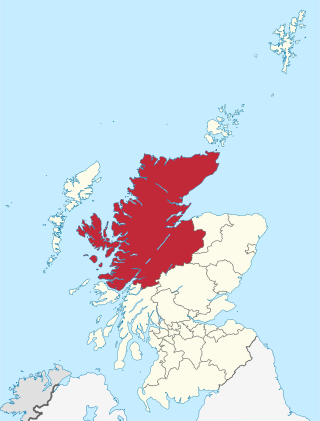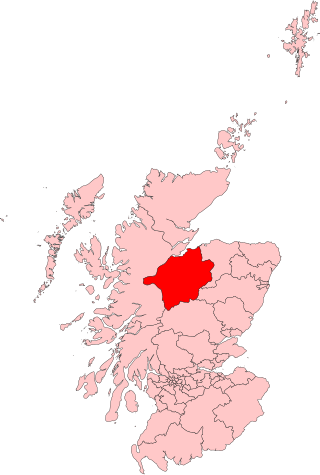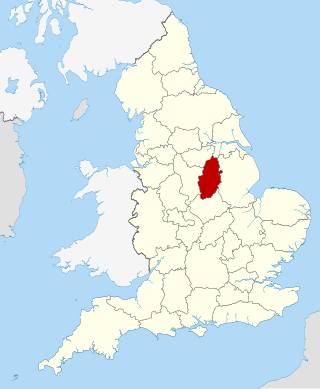
Highland is a council area in the Scottish Highlands and is the largest local government area in the United Kingdom. It was the 7th most populous council area in Scotland at the 2011 census. It shares borders with the council areas of Aberdeenshire, Argyll and Bute, Moray and Perth and Kinross. Their councils, and those of Angus and Stirling, also have areas of the Scottish Highlands within their administrative boundaries.

Lochaber is a name applied to a part of the Scottish Highlands. Historically, it was a provincial lordship consisting of the parishes of Kilmallie and Kilmonivaig, as they were before being reduced in extent by the creation of Quoad Sacra parishes in the 19th century. Lochaber once extended from the Northern shore of Loch Leven, a district called Nether Lochaber, to beyond Spean Bridge and Roybridge, which area is known as Brae Lochaber or Braigh Loch Abar in Gaelic. Lochaber is now also used to refer to a much wider area, one of the 16 ward management areas of the Highland Council of Scotland and one of eight former local government districts of the two-tier Highland region. The main town of Lochaber is Fort William.

Inverness, Nairn, Badenoch and Strathspey is a constituency of the House of Commons of the UK Parliament. As with all seats since 1950 it elects one Member of Parliament (MP) by the first past the post system of election.

Ross, Skye and Lochaber is a constituency of the House of Commons of the Parliament of the United Kingdom (Westminster). It elects one Member of Parliament (MP) by the first past the post system of election.

The Highlands and Islands is an area of Scotland broadly covering the Scottish Highlands, plus Orkney, Shetland, and the Outer Hebrides.
Inverness was a county constituency of the House of Commons of the Parliament of the United Kingdom from 1918 until 1983. It elected one Member of Parliament (MP) by the first-past-the-post system of election.

The Northern Constabulary was the territorial police force responsible for Northern Scotland, covering the Highland council area along with the Western Isles, the Orkney Islands and the Shetland Islands, which make up most of the Highlands and Islands area. It was the police force covering the largest geographical area in the United Kingdom, equivalent to the size of Belgium, but was one of the smallest in terms of officers, with about 715 officers. The Constabulary was one of those amalgamated to form Police Scotland in 2013.

Fife Constabulary was the territorial police force responsible for the Scottish council area of Fife.

Nottinghamshire Police is the territorial police force responsible for policing the shire county of Nottinghamshire and the unitary authority of Nottingham in the East Midlands area of England. The area has a population of just over 1 million.

The Isle of Man Constabulary is the national police service of the Isle of Man, an island of 85,000 inhabitants, situated approximately equidistant from Northern Ireland, Wales, Scotland and England.
Inverness Constabulary was a police force in Scotland that covered Inverness-shire.

Lochaber High School is a six-year comprehensive secondary school located in the town of Fort William, Lochaber, in the Highland region of Scotland.
The Inverness Burgh Police was the police force responsible for the Royal Burgh of Inverness, Scotland from 1847 until 1968.

The Mod Cup, also known as the Aviemore Cup1995 - Royal National Mòd Programmes and fringe events > Royal National Mòd Programmes > [Mod / Mòd Naìseanta Rìoghail - An Comunn Gaidhealach - National Library of Scotland] is a trophy in the sport of shinty first competed for in 1969, traditionally played for by the two teams who are based closest to the host venue of the Royal National Mod. The current holders are Aberdour.(2022)

Inverness-shire is a historic county, registration county and lieutenancy area of Scotland. Covering much of the Highlands and Outer Hebrides, it is Scotland's largest county, though one of the smallest in population, with 67,733 people or 1.34% of the Scottish population.
The New Year Honours 1913 were appointments by King George V to various orders and honours to reward and highlight good works by members of the British Empire. They were announced on 3 January 1913.
The New Year Honours 1926 were appointments by King George V to various orders and honours to reward and highlight good works by members of the British Empire. They were published on 29 December 1925.
The 1932 New Year Honours were appointments by King George V to various orders and honours to reward and highlight good works by citizens of the United Kingdom and British Empire. They were announced on 29 December 1931.
Sir William George MacKenzie Sutherland, often known as Bill Sutherland, was a British police officer.












